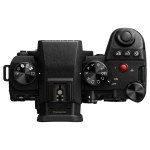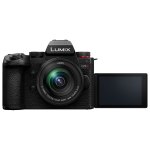The LUMIX G9II
“Capture the Decisive Moment”
Powerful new Micro Four Thirds flagship delivers accurate auto-focus, high speed response and outstanding photographic performance.
Sydney, 13 September 2023: Panasonic is proud to announce the launch of the LUMIX G9II digital mirrorless camera. This powerful new Micro Four Thirds flagship is the first G Series to offer Phase Detection Auto-Focus (PDAF) technology and features a brand-new sensor and engine.
Aaron Waters, Product Marketing Manager of Imaging at Panasonic said: “This camera’s impressive enhancements will delight G Series photographers with fast and reliable image capture in the field. Improvements spanning from Auto-focus to burst-shooting and stabilisation reward the shooter by empowering them to record fleeting moments. And it’s backed by our highly mobile and extensive Micro Four Thirds lens lineup. The two LEICA telephoto lenses announced today allow users to choose from a 32-strong lineup – making it easy to select the perfect kit.”
“The G9II is also a creative workflow dynamo, with REAL TIME LUT, Full Sensor 4:3 ‘open gate’ video recording, Apple ProRes video, 300fps slow motion & more on board.”
LUMIX G9II: Key Capabilities
The camera’s new 25.2-megapixel Live MOS sensor delivers high resolution and high-speed response, supporting V-Log/V-Gamut and 13+ stops of wide dynamic range (1). The new engine achieves natural, three-dimensional textured images and ensures high-speed processing of high bitrate video.
The hybrid PDAF technology on board the LUMIX G9II enables accurate auto-focus and high-speed tracking of fast-moving subjects. New AI-powered recognition technology (developed using AI deep learning) for real-time auto-focus now recognises cars, motorcycles, and animal eyes for improved precision.
To deliver fast action photography, the LUMIX G9II offers burst shooting at 60 fps (AFC) and Super High Speed (2) pre-burst recording (3) that can commence shooting up to 1.5 seconds prior to shutter release, including support for RAW files. A blackout-free Live View Finder means the user can continuously track and keep the subject in focus.
Providing incredible stabilisation for hybrid shooters, the excellent LUMIX image stabilisation system is further enhanced. For photographers, the in-body IS offers an impressive 8-stop at 60mm (4), and when shooting with ultra-telephoto focal length, the Dual I.S 2 system offers 7.5-stop (5) at 140mm (280mm 35mm equivalent). Videographers will appreciate the Active I.S. technology which is optimised for video shooting, offering smooth gimbal-like video even when walking with the camera.
These capabilities provide even greater support for handheld shooting at ultra-telephoto focal lengths, capturing difficult, dynamic subjects such as wildlife. Using the precision gyro-sensor and in-body stabilisation unit, 100-megapixel images can be captured in camera using the High Resolution mode both with a tripod or when handheld.
There are also several modes that expand the possibilities of creativity. The 13+ stop V-Log/V-Gamut capture offers a high dynamic range, consistent colour management and streamlined post-production. With in-camera colour grading via REAL TIME LUT, creative scope is increased while workflow is reduced – excellent for repeatable setups such as content creators who work in the same studio or are looking to repeat the same style in camera instead of applying the same LUT in post. The newly-added LEICA Monochrome mode provides deep black/white contrast.
The Live View Composite Mode takes away the guess work, allowing the photographer to set the desired exposure, take the shot, then view the image on-screen as it is being exposed in real time. Once they are happy with how the shot looks, they simply hit the shutter button again to stop the exposure. This mode is also great for light painting, shooting light trails and other long exposure scenarios.
The G9II is a launching point for video creation. It includes 4:2:0 10-bit 5.8K (4:3) full sensor recording/ 5.7K (17:9), enabling flexible framing options for various social media formats, as well as 4:2:0 10-bit C4K/4K 120p/100p to enable slow motion videos. Recording and playback are supported using an external SSD via USB.
It also offers Apple ProRes (6) video, which delivers high image quality at low compression, reducing computer load during post-production and allowing non-linear editing without transcoding, streamlining workflow from start to finish.
Panasonic is pleased to introduce a new optional battery grip (DMW-BG1E) equipped with an eight-direction joystick that is compatible with the LUMIX G9II and the already available LUMIX S5II and S5IIX.
LUMIX G9II: Pricing and Availability
- DC-G9M2GN: Body only: RRP $3299
- DC-G9M2M: Kit with 12-60mm F3.5-5.6 lens: RRP $3599
- DC-G9M2LEICA: Kit with Leica DG 12-60mm F2.8-4 lens: RRP $4399
- DC-G9M2LPRO: Kit with Leica DG 12-35 F2.8 lens: RRP $4799
- DMW-BG1E: RRP $599
The camera and battery grip will be available in Australia from leading photographic specialists in late October 2023.
Footnotes
- When shooting video at a setting of over 60 fps (including slow and quick mode), the luminance range provides 12+ stops. The dynamic range boost will not function when shooting video at a setting of over 60 fps (including slow and quick mode), when using the SH burst function for still images, and when combining slow shutter speeds of more than 1/15 seconds with ISO.
- Available in electronic shutter only.
- When the ambient temperature is high or Pre-Burst recording is performed continuously, even if you press the shutter button halfway, Pre-Burst may not operate to protect the camera from overheating. Wait until the camera cools down.
- Based on the CIPA standard [Yaw/Pitch direction: focusing distance f=60mm (35mm film camera equivalent f=120mm), when H-ES12060 is used.
- Based on the CIPA standard [Yaw/Pitch direction: focusing distance f=140mm (35mm film camera equivalent f=280mm), when H-FSA14140 is used.
- Apple and ProRes are trademarks or registered trademarks of Apple Inc. in the United States and/or other countries.- Please see the website for video performance information, details, and specifications of the LUMIX G9II.
Micro Four Thirds™ and Micro Four Thirds Logo marks are trademarks or registered trademarks of OM Digital Solutions Corporation, in Japan, the United States, the European Union and other countries.
Images
Commentary
I can’t comment in depth about the long-awaited G9II as I am still digesting the product pages, reviews and videos for all the necessary fine details.
However, a couple of respectful suggestions and some questions for the creators of the press release:
- This is a key capability that cannot be assumed but needs to be stated – C4K/4K 60p 4:2:2 10-Bit Video Recording – stating just “4:2:0 10-bit C4K/4K” risks readers assuming that the camera may not offer 4:2:2.
- Thank you for the large collection of product and lifestyle photographs as always but please strive for representational equity with half featuring females and half being of males using the camera and lenses.
- May I suggest supplying some in-studio product photographs like the ones used in the Panasonic Australia press release page in the Links list below?
- There seems to be one product photograph missing, the camera-only right-side view with doors opened.
- May I also suggest dusting cameras and lenses off before photographing them, especially when on location?
Links
- B&H Affiliate Link – Click here to research and purchase or pre-order your choice of cameras, lenses and accessories for stills photography and video production whatever your genre and subject matter.
- Panasonic Australia – The LUMIX G9II “Capture the Decisive Moment”
- Panasonic North America – The LUMIX G9II “Capture the Decisive Moment”

























































































